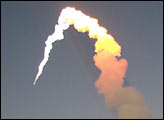Description:
Can you guess what is shown in this photo? What is the plume
extending upward from the ground? Why is the top of the plume
brighter than its bottom? What is the bright object in the lower
righthand corner of the picture, and what is the dark, cone-shaped
feature that seems to be leaving the plume and converging on the
bright object? Examine the picture carefully, look at the
high-resolution version if you want to, and see if you can figure
out the answers to these questions. Then, read the caption below to
test yourself.
What is the Plume?
This is a photograph of the Space
Shuttle (STS-98) launch on February 7, 2001, at 6:13 p.m. eastern
time. The whitish plume is the pillar of smoke and steam left behind
by the solid rocket boosters. Looking carefully, you can see a very
bright dot at the top of the column of smoke, which is the flame
still visible at the base of the solid rocket boosters. Even as the
Space Shuttle is blasting into orbit, lower-level winds have begun
to twist its pillar of smoke.
Why is the top part of the plume brighter?
This photo
was taken near sunset, when the sun was relatively low on the
western horizon. In the photo, you are looking eastward. The top
portion of the plume is much brighter because it is being
illuminated directly by sunlight, whereas the bottom portion of the
plume lies within the Earth's shadow.
What is the bright object?
The bright orb in the lower
righthand corner of the picture is the full, sunlit face of the moon
which has already risen above the eastern horizon.
What is the dark feature?
The dark, cone-shaped
feature extending downward and eastward from the pillar of smoke is
its shadow, known as the Burgeron Effect (not uncommon when launches
are around sunrise or sunset). The shadow exists in the air because
there are aerosol particles in the air that reflect and scatter
sunlight everywhere except where the sunlight is being blocked by
the pillar of smoke. Thus, that part of the sky appears darker.
Why does the shadow point at the moon?
Because the
launch took place on the evening of a full moon, any shadow cast
would have to appear to end at the moon since the Earth, moon, and
sun were naturally in alignment. Remember, you are looking eastward
at the moon and the sun is above and behind you in this
perspective. |

